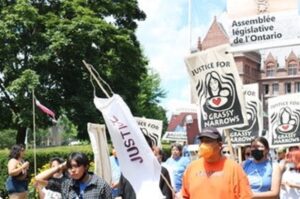Grassy Narrows First Nation continues to fight against environmental injustices with Grassy Narrows River Run

By Justin Rhoden
TORONTO— “We need the land to heal for our people to heal,” said Grassy Narrows Chief Randy Fobister in his remarks to the public at Grassy Narrows River Run.
On July 21, 80 Grassy Narrows First Nations members travelled 1,800km to Toronto, demanding justice for their community with the Grassy Narrows River Run 2022 march.
The march began at noon at the Ontario Legislative Building at Queen’s Park in downtown Toronto where provincial politicians such as the recently re-elected Premier Doug Ford office resides. After an opening address and song by Elder Gary Sault from the Mississaugas of the Credit First Nation, community members and supporters’ speeches detailed some of the community’s experiences and the need for immediate action.
Grassy Narrows is currently living in one of the worst cases of environmental poisoning in Canada, with high levels of mercury in their waterways.
More than 60 years ago, Dryden Chemicals Limited, a paper mill company owned by Reed Paper, began dumping tonnes of mercury into the Wabigoon River, upstream from Grassy Narrows. In 1970, the community learned that the fish caught by the local fisheries had a dangerous level of mercury caused by the paper company.
As a result, Grassy Narrows’ relationship with fisheries began to change, affecting the community’s well-being and way of life. Employment rates plundered from 90 per cent to 10 per cent as the traditional economies suffered. Today, 90 per cent of the community’s population shows mercury poisoning symptoms, including numbness, tremors, and anxiety.
In a pre-recorded address to Grassy Narrows youth and attendees at the Ontario Legislature building, community member Chrissy Issacs explained that “the mercury put into this water robbed us of a way of life… our people have been living off this river, and they take that away from us.”
Sol Mamakwa, member of Kingfisher Lake First Nation and of the Ontario New Democratic Party representing Kiiwetinooong, declares that this “is environmental colonialism, this is environmental oppression, and it is not right…”
After a succession of speeches from community members, supporters in solidarity, and captivating performances, the crowd led by community members began marching. Banners, signs, posters, and colourful giant puppets moved through the streets of Toronto alongside chants for justice and an explicit declaration of the inseparable relationship between the water and the peoples who rely on it- “What happens to the water happens to the people.”
At College and Bay Street, the marching came to a pause. Songs and the sounds of drumming by men in the community echoed through the streets, drawing the attention of passerby in the surrounding area. Soon after, the crowd continued down Bay Street to Toronto’s Indigenous Services Canada Office; here, community members made their demands clear.
Firstly, they insisted on fair compensation for all Grassy Narrows community members regarding the ongoing mercury crisis. The river run organizers share that “86 per cent of community members get no compensation for the ongoing crises that impact their health, culture, livelihood, rights, and environment.”
Secondly, they demanded that the government respect the Grassy Narrows Indigenous protected area and end all mining and logging plans in Grassy Narrows territory. This demand is in response to irresponsible and unauthorized logging of Grassy Narrows land by multi-national corporations like Weyerhaeuser, who is operating under permission by the Government of Ontario without any consent from the Grassy Narrows community. Approximately 50 per cent of Grassy Narrows’ land is impacted. After logging, the sacred land is poisoned with chemicals from herbicides to set up monoculture tree farms that substitute traditional plants used for medicinal purposes in the community since time immemorial.
The final demand was that the government support Grassy Narrows in restoring their community and way of life from the mercury’s damage.
In addition to their demands from the government, the community is calling people to action. Chief Randy Fobister encourages people to learn about the impact of mercury on Grassy Narrows First Nation.
Their website, freegrassy.net, also details different avenues to support Grassy Narrows, such as signing the petition for Mercury Justice, demanding Prime Minister Justin Trudeau deliver on his promise to build the Mercury Home, diverting investments from companies like Weyerhaeuser, and spreading the word.
Youth leader Steve Fobister Jr. notes in his address to the public that the power of people coming together is what the government fears, and it is essential that we continue to come together to support. Many youth who spoke during the march, like Forbister Jr., are meeting the injustices their community faces with unwavering hope and commitment. This hope and commitment is a clear and persistent sentiment throughout the march as each Grassy Narrows speaker echoes their Chief, who affirms that “we are not going to stop, and we are going to keep fighting for justice.”


